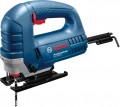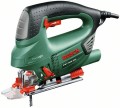Real power
The power produced by the jigsaw “at the output”, in other words, supplied to the saw blade. It is always less than the power consumption (see above) due to energy losses in the tool mechanisms. It is the useful power that is the main parameter that determines the flow Rate and suitability of a jigsaw for heavy work: the higher the power, the thicker and/or harder the material the tool can “take” and the faster it can handle the job. On the other hand, tools with higher power consume more electricity (see “Power Consumption”), and are also noticeably heavier than less powerful counterparts. Therefore, it is worth choosing a jigsaw based on power, taking into account the expected volume of work and the characteristics of the materials used.
Power consumption
The maximum electrical power consumed by the jigsaw during operation. It is worth noting that this parameter uniquely determines only the amount of electricity spent on the operation of the tool; its practical characteristics, for example, the thickness of the material and the speed of operation, depend primarily on the output power (see below). On the other hand, the output power is not always indicated by the manufacturer, and therefore a comparison by power consumption is quite acceptable — to a certain extent, it allows you to evaluate the characteristics of the tool. So, it is believed that electric jigsaws up to 600 W are enough for domestic use, and
more powerful models belong to the professional segment. For more information on selecting a jigsaw for power, see "Output Power".
Minimum frequency
The minimum stroke frequency of the jigsaw blade during operation. In some cases (for example, when working on metal), a low stroke rate is preferable to a high one; accordingly, the lower the minimum frequency, the more opportunities you will have to set up the instrument for working on a particular material.
Stroke
The length of the stroke of the working blade of the jigsaw during operation. The longer the stroke, the more of the file will be in contact with the material in one movement; accordingly, at the same frequency of movement of the blade, a jigsaw with a longer stroke length will be more performant.
Wood
Maximum cutting depth in wood, in other words — the maximum thickness of a wooden workpiece that a jigsaw can handle. This parameter characterizes not only directly the maximum thickness of the material, but also the performance of the tool as a whole: the greater the depth of cut, the higher the performance. In the case of wood for domestic use, a depth of about 70 mm is considered sufficient, deeper models are usually professional.
It is worth noting that the depth of cut is usually indicated for certain files recommended by the manufacturer for a particular material. The use of other canvases does not guarantee compliance with the claimed parameters, and in some cases it is even fraught with breakdowns and injuries.
Aluminium
The maximum cutting depth when working on aluminium and its alloys, in other words, the maximum thickness of a workpiece made of these materials that a jigsaw can cut through. In general, aluminium and its alloys are softer than steel, and therefore the depth of cut through them is greater - in professional models it can reach 30 mm.
Steel
The maximum depth of cut in steel, in fact, is the maximum thickness of a workpiece made of steel or other metal of similar characteristics that a jigsaw can handle. For more information about the depth of cut, see "Wood", here we note that due to the hardness of the material, even in professional models, this parameter rarely exceeds 10 mm.
Functions
—
Soft start. With a normal start, the jigsaw motor reaches operating speed very quickly. A sharp jerk of the tool at the same time can ruin the work and increases the risk of letting the jigsaw out of your hands, which is fraught with various unpleasant consequences. In addition, high starting currents, characteristic of modern electric motors, increase their wear and tear, and are undesirable for the power grid. The soft start system avoids the troubles described above: the speed increases smoothly, the jerk of the tool is minimal, and the starting currents are low. This feature is especially important for high power jigsaws (from 600 W).
—
Adjustment of turns. This function allows you to select the optimal stroke rate for different types of materials: for example, soft materials such as wood can be worked at high speeds, while hard materials (metal, ceramics, etc.) are recommended to be worked at low speed. See "Min. frequency" and "Maximum frequency".
— Presetting the number of revolutions. The function provides the fastest speed presetting. The stroke rate of the cutting tool is selected for optimal work with workpieces made of certain materials.
—
Maintaining momentum. An electronic system that regulates the power supplied to the working tool so that the speed of its work is constant regardless of the load. This improves the quality and pro
...ductivity of work, as well as the service life of the tool and the jigsaw itself.
— Brushless motor. The presence of a brushless electric motor in the jigsaw. The carbon brushes used in traditional electric motors run with a lot of friction, get very hot, tend to spark, and wear out relatively quickly. Accordingly, brushless motors are safer, more economical and more durable. Their main disadvantage is their high cost.
— Keyless file replacement. The ability to replace the jigsaw blade without the use of special tools (wrenches, screwdrivers, etc.) — thanks to a special mount that can be opened and closed by hand. This feature greatly simplifies and facilitates the process of changing the blade.
— Anti-vibration system. A mechanism or system of mechanisms designed to reduce the vibration of a tool during operation. Strong vibrations not only worsen the quality and accuracy of cuts, but also increase tool wear, lead to rapid fatigue of the operator, and during prolonged work, they also adversely affect health. To prevent all this, various designs are used in the form of shock absorbers, counterweights, etc.
— Sawdust blowing system. The possibility of blowing sawdust from the place of cutting directly during the operation of the jigsaw. It is usually implemented by a fan that provides cooling for the electric motor: the air flow is directed to the web, and the resulting waste is immediately blown away. Thus, the sawdust does not cover the marking line, which greatly facilitates the work, especially with complex figured cuts.
— Connecting a vacuum cleaner. Possibility of connecting an external vacuum cleaner to the jigsaw; for this, the tool is equipped with a special nozzle. The role of such a vacuum cleaner is similar to the blowing system (see above): it is primarily designed to clean the cutting line from sawdust and other debris. However, at the same time, the vacuum cleaner also additionally ensures cleanliness: sawdust does not scatter around the room, but is collected in a dust collector. At the same time, there is a drawback: the tool becomes more cumbersome and less suitable for complex jobs.
— Built-in lighting. The jigsaw has its own lighting system in the form of a flashlight aimed at the work area. Such a tool allows you to work in low light conditions without any additional light sources.
— Laser marker. The presence of a laser marker-target designator in an electric jigsaw: such a marker projects a light mark onto the workpiece during operation, which indicates where the cut will go. This greatly improves the accuracy of the work.In box
- Charger. A device for charging the batteries used in the tool with the appropriate power supply. For models supplied with such a device, the charger model may be additionally specified in the characteristics. This information can be useful not only for finding a spare or replacement charger, but also in case the household has other cordless tools and / or batteries for them. On the other hand, a lot of modern cordless tools come without a charger at all. This option will be optimal, first of all, if a compatible memory is already available, and there is simply no need to overpay for a second device. In addition, the lack of a charger will be appreciated by those who want to choose this accessory separately, without relying on the manufacturer's decision.
-
Rubberized handle. The presence of a rubber pad on the handle of the jigsaw. Rubber provides a more secure hold on the tool than plastic, and also helps reduce vibration transmitted to the operator's hands. In some models, rubber pads are made corrugated - for additional reliability.
-
Protective shield. The presence in the design of the jigsaw of a transparent (usually plexiglass) protective shield in the front, near the file. It prevents fine sawdust from being scattered during operation, and also improves blowing or suction efficiency (if these functions are present, see "Functions/Features" for more details). In most cases, the p
...rotective shield is made removable.
- Case included. The presence of a special suitcase-case in the delivery set of the jigsaw. Such a case greatly facilitates storage and transportation, because. initially “sharpened” for a specific jigsaw model. In addition, additional accessories can usually be stored in it: replacement files, a tool for changing them (if required), a spare battery, etc.
- Flexible shaft. The flexible shaft is a special kind of auxiliary nozzle. Outwardly, this device looks like a hose, sometimes quite long. One end of such a "hose" is attached to the cartridge, and the other has its own cartridge, where the working nozzle is attached - rotation is transmitted to it due to the shaft located inside the "hose". The part of the flexible shaft held in the hands during operation is more compact and lighter than the jigsaw itself, so the most popular ways to use such equipment are the processing of hard-to-reach places (where the tool simply cannot crawl through) and fine work (which is difficult to do with a massive machine).
- Pedal. The presence of the pedal frees the hands of the master and allows you to adjust the speed of rotation of the nozzle by changing the pressure on the pedal. The dependence here is directly proportional - the stronger the pressure, the higher the speed.
